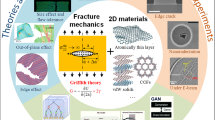Abstract
A quantitative assessment of the density of hyperbolic markings in the fracture surfaces of polymethyl methacrylate has been made showing that the density is proportional to the fracture toughness. In general the fracture toughness at any instance is a random function, but there is a definite tendency for it to increase with velocity of fracture propagation.
It is suggested that the craze material ahead of the true crack tip may be assumed to have constant strength and Dugdale's model for elasto—plastic materials applied to organic glasses as well.
Résumé
Une mesure quantitative de la densité de stries hyperboliques sur les surfaces de rupture de methacrylate de polymethyle a permis de démontrer que la densite des stries est proportionnelle a la ténacité à la rupture du materiau. En règle générale, la ténacité est à tout moment une fonction statistique; il semble toutefois qu'elle tende a s'accroître avec la vitesse de propagation de fissure.
On suggère que la zone de matière qui se trouve en avant de 1'extrémité de la fissure réelle puisse être considérée comme ayant une résistance constante, et que le modèle de Dugdale pour l'ètude des matériaux élasto-plastiques est applicable a l'étude des verres organiques.
Zusammenfassung
Es wurde eine quantitative Einschätzung der Festigkeit von Hyperbelmarkierungen in den Bruchoberflachen von Polymethyl-Methacrylaten vorgenommen welche zeigte, dass die Festigkeit proportional zur Bruchfestigkeit ist. Die Bruchfestigkeit ist gewöhnlich eine Zufallsfunktion, aber sie hat definitive Tendenz sich mit der Bruchverbreltungsgeschwindigkeit zu vergrössern.
Es wurdeangenommen, dass das Rissmaterial vor der wahren Rissspitze konstante Kraft hat and dasDugdale's Modell für elastisch—plastisches Material auch für organisches Glass angewandt werden kann.
Similar content being viewed by others
References
R.P. Kambour J. Poly. Sci., A2, 4159–4163 (1964).
R.P. Kambour J. Poly. Sci., A2, 4165–4168 (1964).
I. Wolock & S.B. Newman Fracture Processes in Polymeric Solids, Ed. B.Rosen, Wiley & Sons, New York, 236–290 (1964).
B. Cotterell Appl. Matls. Res., 4, 227–232 (1965).
J.P. Berry Fracture Processes in Polymeric Solids, Ed.B.Rosen, Wiley & Sons, New York, 195–233 (1964).
R.P. Kambour J. Poly. Sci., A2, 4, 349–358 (1966).
G.I. Barenblatt & G.P. Cherepanov J. Appl. Math. & Mech., 24, 993–1014 (1960).
R.P. Kambour Polymer, 5, 143–155 (1964).
K.B. Broberg Arkiv för Fysik, 18, 159–192 (1960).
B. Cotterell Inter. J. Frac. Mech., 1, 96–104 (1965).
J. Leeuwerik Rheo. Acta, 2, 10–16 (1962).
G.I. Barenblatt Adv. in Appl. Mech., 7, 56–125 (1962).
D.S. Dugdale J. Mech. & Phys. of Solids, 8, 100–105 (1960).
J.N. Goodier & F.A. Field Fracture of Solids, Ed. D.C. Drucker and J.J. Gilman, Wiley and Sons, New York, 103–119 (1963).
Author information
Authors and Affiliations
Rights and permissions
About this article
Cite this article
Cotterell, B. Fracture propagation in organic glasses. Int J Fract 4, 209–217 (1968). https://doi.org/10.1007/BF00185257
Received:
Issue Date:
DOI: https://doi.org/10.1007/BF00185257




